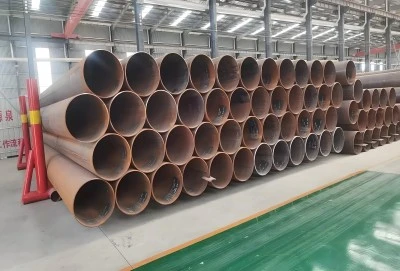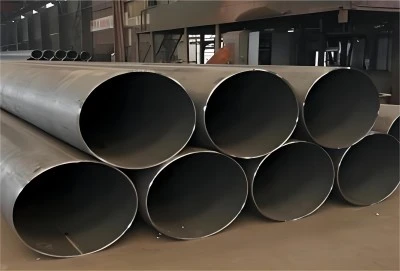When it comes to selecting the right steel pipe for your project, understanding its temperature capabilities is crucial. API 5L X60 PSL2 pipe, a high-quality steel pipe widely used in the oil and gas industry, is known for its excellent performance in various temperature conditions. In this comprehensive guide, we'll explore the temperature range suitable for 5L X60 PSL2 pipe, its characteristics, and why it's a popular choice for many applications.
|
|
|
Understanding API 5L X60 PSL2 Pipe: A Brief Overview
API 5L X60 PSL2 pipe is a type of steel pipe manufactured according to the American Petroleum Institute (API) 5L standard. The "X60" designation refers to the pipe's minimum yield strength of 60,000 psi (414 MPa), while "PSL2" indicates that it meets the more stringent Product Specification Level 2 requirements.
This high-strength steel pipe is widely used in the oil and gas industry for applications such as pipelines, offshore platforms, and other critical infrastructure. Its popularity stems from its excellent combination of strength, toughness, and weldability, making it suitable for a wide range of operating conditions.
One of the key factors that determine the suitability of 5L X60 PSL2 pipe for various applications is its temperature range. Understanding this range is essential for engineers and project managers to ensure the pipe's performance and longevity in different environmental conditions.
Temperature Range for API 5L X60 PSL2 Pipe: 0°C (32°F) and Above
The API 5L X60 PSL2 pipe is suitable for use in temperatures of 0°C (32°F) and above. This temperature range is based on the API 5L standard, which specifies the testing requirements for these pipes. Let's delve deeper into why this temperature range is significant and how it affects the pipe's performance.
The lower temperature limit of 0°C (32°F) is crucial because it represents the point at which water freezes. At temperatures below freezing, steel can become more brittle, potentially affecting its mechanical properties. By setting the lower limit at 0°C, the API 5L standard ensures that the pipe maintains its intended strength and toughness in most operating conditions.
It's important to note that while 0°C is the standard test temperature, API 5L X60 PSL2 pipes can often perform well at even lower temperatures. However, for applications requiring operation below 0°C, additional testing and considerations may be necessary to ensure the pipe's suitability and safety.
The upper temperature limit for API 5L X60 PSL2 pipe is not as strictly defined as the lower limit. These pipes can generally withstand high temperatures, but the exact upper limit depends on various factors, including the specific application, operating pressure, and environmental conditions. For high-temperature applications, it's crucial to consult with experts and conduct thorough analysis to ensure the pipe's suitability.
Testing Standards and Temperature Considerations for API 5L X60 PSL2 Pipe
To ensure the reliability and performance of API 5L X60 PSL2 pipe across its intended temperature range, several testing standards are employed. These tests are designed to evaluate the pipe's mechanical properties and behavior under various conditions. Let's explore two key tests that are particularly relevant to temperature considerations:
1. Weld and Heat Affected Zone (HAZ) Testing:
According to the API 5L standard, the test temperature for the weld and heat affected zone (HAZ) is 0°C (32°F). This test is crucial because welding can affect the microstructure and properties of the steel in and around the weld area. By testing at 0°C, manufacturers can ensure that the welded joints maintain their strength and integrity even at the lower end of the pipe's temperature range.
The weld and HAZ test typically involves impact testing, such as the Charpy V-notch test, which measures the material's toughness at the specified temperature. This test helps identify any potential weak points in the welded areas that could lead to failure under low-temperature conditions.
2. Drop Weight Tear Test (DWTT):
The Drop Weight Tear Test (DWTT) is another critical test conducted on API 5L X60 PSL2 pipe, and it is also performed at 0°C (32°F). This test evaluates the pipe's resistance to brittle fracture, which is particularly important for low-temperature applications.
During the DWTT, a large, notched specimen of the pipe material is subjected to impact loading at the specified temperature. The test assesses the percentage of shear area on the fracture surface, which indicates the material's ability to resist brittle fracture propagation. A high percentage of shear area suggests good low-temperature toughness, while a low percentage may indicate a tendency towards brittle behavior.
By conducting these tests at 0°C, manufacturers can ensure that API 5L X60 PSL2 pipe maintains its ductility and toughness at the lower end of its operating temperature range. This is crucial for preventing catastrophic failures in critical applications such as oil and gas pipelines.
3.Factors Influencing Temperature Performance:
While the API 5L standard sets the baseline for temperature performance, several factors can influence how well API 5L X60 PSL2 pipe performs across its temperature range:
- Chemical Composition: The precise chemical makeup of the steel can affect its low-temperature toughness. Elements like nickel and molybdenum can improve low-temperature performance.
- Manufacturing Process: The pipe's production method, including rolling and heat treatment processes, can impact its microstructure and, consequently, its temperature-related properties.
- Wall Thickness: Thicker pipe walls generally provide better resistance to low-temperature embrittlement.
- Operating Pressure: Higher operating pressures can increase the risk of brittle fracture, especially at lower temperatures.
- Environmental Factors: Exposure to corrosive substances or extreme weather conditions can affect the pipe's long-term performance across its temperature range.
Understanding these factors is crucial for engineers and project managers when selecting and implementing API 5L X60 PSL2 pipe in various applications. It's often necessary to consider additional testing or special measures for projects that push the boundaries of the standard temperature range.
Applications and Considerations
API 5L X60 PSL2 pipe finds extensive use in various applications, particularly in the oil and gas industry. Its suitability for temperatures of 0°C (32°F) and above makes it an excellent choice for many projects, including:
- Onshore and offshore pipelines
- Gas gathering systems
- Oil refineries
- Petrochemical plants
- Water transportation systems
When considering API 5L X60 PSL2 pipe for your project, it's essential to take into account the following factors:
- Minimum Design Temperature: Ensure that the lowest expected operating temperature is within the pipe's capabilities.
- Cyclic Temperature Changes: Consider the effects of repeated temperature fluctuations on the pipe's long-term performance.
- Insulation Requirements: For applications where maintaining a specific temperature is crucial, proper insulation may be necessary.
- Expansion and Contraction: Account for thermal expansion and contraction in the pipeline design, especially for systems with significant temperature variations.
- Special Requirements: For applications involving temperatures below 0°C or extreme high temperatures, consult with experts to determine if additional testing or special grades of API 5L pipe are needed.
By carefully considering these factors and working closely with reputable manufacturers and engineers, you can ensure that API 5L X60 PSL2 pipe is correctly specified and implemented in your project, maximizing its performance and longevity across its intended temperature range.
China api 5l x60 psl2 steel pipe
API 5L X60 PSL2 pipe offers excellent performance across a wide temperature range, making it a versatile and reliable choice for many applications in the oil and gas industry. Its suitability for temperatures of 0°C (32°F) and above, combined with rigorous testing standards, ensures that this high-strength steel pipe can maintain its mechanical properties and integrity under various operating conditions.
Understanding the temperature range and associated testing requirements for API 5L X60 PSL2 pipe is crucial for engineers, project managers, and decision-makers in the industry. By considering factors such as chemical composition, manufacturing processes, and specific project requirements, you can make informed decisions about implementing this versatile pipe in your projects.
If you are choosing your China api 5l x60 psl2 steel pipe manufacturers, welcome to contact LONGMA GROUP at info@longma-group.com. Our team of experts is ready to assist you in selecting the right pipe for your specific application, ensuring optimal performance and longevity across the intended temperature range.














